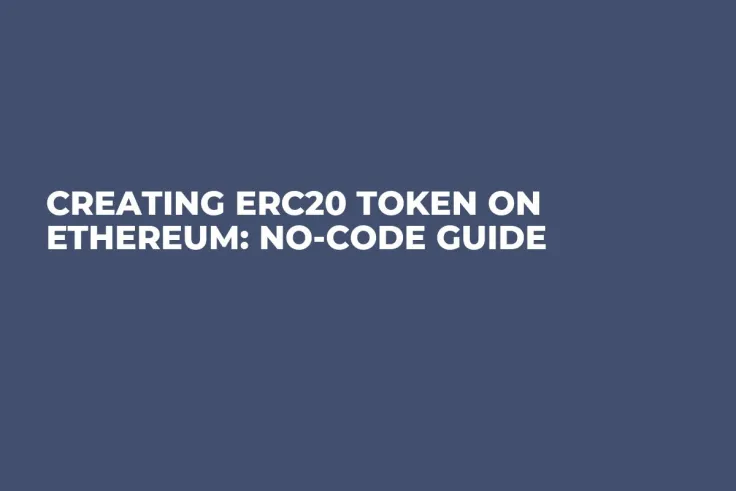
Disclaimer: The opinions expressed by our writers are their own and do not represent the views of U.Today. The financial and market information provided on U.Today is intended for informational purposes only. U.Today is not liable for any financial losses incurred while trading cryptocurrencies. Conduct your own research by contacting financial experts before making any investment decisions. We believe that all content is accurate as of the date of publication, but certain offers mentioned may no longer be available.
Since its launch in 2015, Ethereum has revolutionized the blockchain industry by being the first to offer optimal support for digital assets like tokens and NFTs.
The primary challenge in Ethereum and the broader crypto ecosystem is that starting your project requires advanced programming knowledge to write a smart contract in Solidity (a programming language developed specifically for Ethereum)
Because of this, most people interested in Web3 would find themselves limited to being users rather than creators due to the technical requirements. However, decentralized applications (dApps) like the Smithii Tool’s Suite have emerged to simplify complex processes, enabling you to create ERC20 tokens without any coding knowledge.
What is an ERC20 token?
ERC20 is Ethereum Request for Comment, and 20 is its identifier number. It is the standard protocol for creating fungible tokens (transferable assets) on Ethereum and other EVM-compatible blockchains.
An ERC20 token can represent a financial asset like Doge, a token within Ethereum Blockchain.
The ERC20 standard has become widespread over the years, allowing wallets, exchanges, and all Ethereum platforms to interact seamlessly, as they all adhere to the same protocol.
Create an ERC20 token on Ethereum without coding
Far from exhausting the potential use cases, let's explore how to create an ERC20 token without programming knowledge. We will use Ethereum Token Creator on Smithii Tools. This dApp functions as a smart contract generator, writing the necessary code for you while presenting a simple and intuitive interface. It is fully audited by CoinFabrik.
- Connect Your Wallet: Connect your Ethereum wallet, such as MetaMask, to the Smithii platform.
- Enter Token Details: Choose the name and symbol for your token.
- Define Token Supply: Set the total supply of your token, which determines the amount of tokens that will be created.
- Token Creation: After reviewing your settings, click 'Create Token,' approve the transaction, and wait for your token to appear in your wallet.
Additional options when creating an ERC20 token
If desired, you can use advanced options when creating your token on Ethereum, such as setting a tax, enabling airdrop mode, and activating anti-bot and anti-whale mechanisms.
Tax: You can select the fee percentage to be retained from each transaction involving your token and designate the wallet address to receive these transaction fees.
Airdrop Mode: By activating airdrop mode, you can prevent users from sending or trading your token until you deactivate this setting.
Anti-Bot: This feature allows you to limit the actions of snipers and bots on your token's liquidity pool by restricting them from making more than one transaction in the same block.
Anti-Whale: A standout feature that enables you to set a maximum amount that a single wallet can buy or sell, enforce a time limit between buy/sell transactions, set a cap on the total tokens one wallet can hold, and, best of all, define the number of days the anti-whale mechanism will remain active, protecting your token from exploits during its initial launch phase.
Launch your ERC20 token on Ethereum
Once you've generated your token's smart contract with Ethereum Token Creator from Smithii Tools, your next step is to create a liquidity pool on Uniswap.
But first, change your token's image/logo. Follow the guide from smithii to learn how to add a logo to your ERC20 token and include social media links or other relevant information to enhance the reach of your project.
Use cases for ERC20 tokens
Businesses use ERC20 tokens for various reasons; some of the most common include:
Asset Tokenization: ERC20 tokens allow the conversion of physical assets, such as real estate or art, into digital tokens, making them easier to trade and more accessible to a broader range of investors.
Governance: Distributing ERC20 tokens within a community can facilitate governance by granting voting rights to token holders in Decentralized Autonomous Organizations (DAOs).
Decentralized Finance (DeFi): ERC20 tokens enable complex financial operations, such as representing a stake in a liquidity pool, by being transferable and allowing automated processes.
Loyalty and Rewards Programs: ERC20 tokens help develop loyalty and rewards programs for a community, incentivizing repeated engagement and customer retention. For example, they can be used to conduct an airdrop on Ethereum without coding.
Fundraising: ERC20 tokens are used as a digital currency to raise funds through Initial Coin Offerings (ICO).
Final thoughts on creating an ERC20 token on the Ethereum blockchain
Creating a token on Ethereum can leave a lasting impact on the blockchain. The type of asset resonates with developers or project owners in the crypto ecosystem because it's a way to engage with the community or investors. Ultimately, everyone in the Web3 space seeks some benefit, and creating a token marks the difference between being a mere user and someone with a greater appetite for innovation.
 Dan Burgin
Dan Burgin Alex Dovbnya
Alex Dovbnya Denys Serhiichuk
Denys Serhiichuk